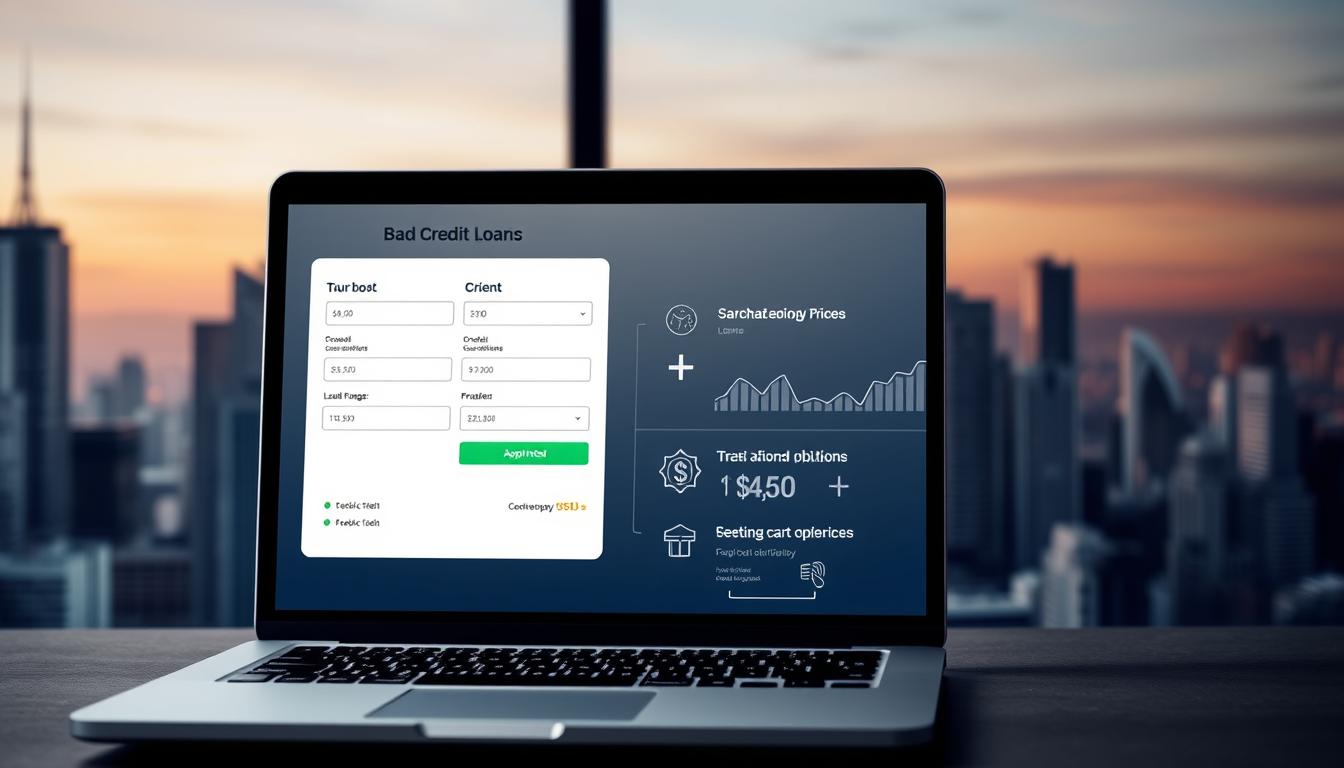Student Loan Refinance: Unlock Savings Today
The average U.S. college graduate has about $30,000 in student loan debt. This debt can feel like a heavy weight. But, there’s a way to lighten the load: refinancing. By refinancing, you might save thousands of dollars over time with lower interest rates.
For example, the interest rate for undergraduate direct loans from July 1st, 2023, to July 1st, 2024, is 5.50%.
Refinancing can make your payments easier and reduce your monthly costs. We look into how refinancing student loans can help you save money by lowering your interest rates.
Key Takeaways
- Refinancing can lower your interest rate and monthly payments.
- Credit score and income are key factors in refinancing eligibility.
- Refinancing federal loans may result in losing certain benefits.
- Potential savings: Thousands of dollars over the life of the loan.
- Simplified payments through consolidation.
What Is Student Loan Refinance?
Student loan refinance helps borrowers manage their loans better. It means swapping one or more loans for a new one. This new loan might have a different interest rate or repayment term.
Definition and Overview
Refinancing student loans means combining them into one loan. This new loan often has better terms than the old ones. It could have a lower interest rate or a different repayment period.
By doing this, borrowers can save money on interest. They also make their monthly payments easier by having just one loan to pay.
A recent report found that borrowers can save up to $10,000 by refinancing. A financial expert says, “Refinancing student loans can be a smart move. It helps lower monthly payments and reduces debt.”
“Refinancing student loans can be a smart move for borrowers who are looking to lower their monthly payments and reduce their overall debt burden.” – Financial Expert
How It Works
To refinance, you apply for a new loan. You can choose to stay with your current lender or look for better rates elsewhere. The new lender pays off your old loans, leaving you with just one to handle.
Keep in mind, refinancing might cost you a loan origination fee. This fee can be between 0.5% and 1% of the loan amount. But, a lower interest rate can save you more money in the long run.
| Aspect | Original Loan | Refinanced Loan |
|---|---|---|
| Interest Rate | 6.0% | 4.5% |
| Repayment Term | 10 years | 15 years |
| Monthly Payment | $333 | $253 |
The table shows how refinancing can cut your monthly payments. But, you might pay more interest over time because of the longer term.
Understanding student loan refinance can help borrowers make smart choices. It can simplify payments, lower interest rates, or improve loan terms. Refinancing is a useful tool for managing student loan debt.
Benefits of Refinancing Your Student Loans
Refinancing your student loans can be a smart move. It can help you save money, make payments easier, and get better loan terms.
Refinancing means swapping your old loan for a new one. This new loan usually has a lower interest rate and better repayment terms. It helps you handle your debt better and use your money wisely.
Lower Interest Rates
One big plus of refinancing is getting a lower interest rate. This can cut down what you pay over time, saving you money.
If you have a high-interest loan and rates have dropped, refinancing can be a smart choice. It can save you a lot, even if you have a big loan.
Simplified Payments
Refinancing also makes payments simpler. It combines multiple loans into one, with just one monthly payment. This makes it easier to keep up with your payments.
Having one loan means you only have to worry about one interest rate and repayment term. It helps you organize your finances better and reach your financial goals.
Better Loan Terms
Refinancing can also give you better loan terms. This might include longer or shorter repayment periods, based on what you need.
Better terms mean more flexibility. They help you manage your debt in a way that fits your financial plan.
When Should You Consider Refinancing?
Knowing when to refinance your student loans is key to reaching your financial goals. Refinancing can lower your interest rates and make payments easier. But, think about several things before you decide.
Life Changes
Big life changes can affect your money situation, making refinancing a good idea. For example, getting a better job, getting married, or having kids can change your money needs. Refinancing can help adjust your loan payments to fit your new financial life.
If you’ve just gotten a higher-paying job, you might be able to refinance. This can lower your interest rates and monthly payments.
Interest Rate Trends
Interest rates are very important when deciding to refinance. When rates are low, it’s a great time to refinance your student loans. This can save you a lot of money over time.
Financial Goals
What you want to achieve with your money is also important. If you want to pay off your loans fast, refinancing to a shorter term might be best. But, if you’re having trouble with monthly payments, refinancing to a longer term could help.
| Financial Goal | Refinancing Option | Potential Benefit |
|---|---|---|
| Pay off loans quickly | Refinance to a shorter loan term | Save on interest, pay off loan faster |
| Reduce monthly payments | Refinance to a longer loan term | Lower monthly payments, improved cash flow |
| Simplify payments | Refinance multiple loans into one | Single monthly payment, reduced complexity |
By thinking about these points and your financial goals, you can decide if refinancing is right for you.
How to Refinance Your Student Loans
To refinance your student loans, you need to know the process well. We aim to help you through the steps to get the best student loan refinance rates.
Refinancing means swapping your old loan for a new one. This new loan might have a different interest rate or payment terms. It might seem hard, but breaking it down helps.
Researching Lenders
The first step is to find lenders to refinance with. Not all lenders offer the same rates or terms. It’s important to compare them.
Look for lenders that focus on refinancing student loans and have good customer service. Some key things to consider are:
- Interest rates: Find lenders with competitive rates.
- Loan terms: Think about the loan’s length and any fees.
- Customer service: Check reviews to see how good the service is.
Comparing Offers
After finding lenders, compare their offers. This is key to finding the best student loan refinance rates. Make sure to read each offer’s terms and conditions well.
| Lender | Interest Rate | Loan Term | Fees |
|---|---|---|---|
| Lender A | 4.5% | 5 years | $0 origination fee |
| Lender B | 4.2% | 7 years | $100 origination fee |
| Lender C | 4.8% | 10 years | $0 origination fee |
By researching and comparing lenders, you can find the best option. This can lead to big savings through refinancing student loans.
Frequently Asked Questions About Refinancing
Many borrowers wonder about refinancing their student loans. They ask if it’s the right choice and what the benefits and drawbacks are. It’s important to get your questions answered to make a smart decision.
Is It Right for Me?
To know if refinancing is right for you, look at your finances and goals. If you have a steady income, good credit, and want to lower your payments, it might be a good choice. Think about the savings and the loss of federal benefits if you refinance federal loans.
“Refinancing can be a great way to take control of your debt, but it’s not for everyone. It’s essential to do your research and consider your options carefully.”
What Will My New Rate Be?
Your new interest rate depends on your credit score, income, and the lender’s terms. Borrowers with excellent credit and stable finances often get better rates. Lenders offer variable and fixed rates. It’s important to compare and understand how each rate affects your payments and total interest.
Can I Refinance Federal Loans?
Yes, you can refinance federal loans with a private lender. But, this choice has big considerations. Refinancing federal loans means losing federal benefits like income-driven plans and Public Service Loan Forgiveness. Think carefully if the benefits of refinancing are worth the loss of these benefits.
Choosing to refinance your student loans should be a well-thought-out decision. By understanding these common questions, you’ll be ready to make a choice that fits your financial future.
Common Myths About Student Loan Refinance
Student loan refinancing is often misunderstood. Many people are hesitant because of false information. They don’t fully understand how refinancing works.
We aim to clear up common myths about student loan refinancing. We want to give borrowers accurate info to help them make smart financial choices.
“I Can’t Refinance Federal Loans”
Many think you can’t refinance federal loans. But, you can refinance them with a private lender. This choice should be made carefully because you’ll lose federal benefits.
Refinancing can save you money on interest. But, consider the loss of federal loan benefits. For more info, check Community America’s blog on student loan refinancing

| Loan Type | Refinancing Option | Potential Benefits |
|---|---|---|
| Federal Loans | Can be refinanced with private lenders | Lower interest rates, simplified payments |
| Private Loans | Can be refinanced with private lenders | Better loan terms, potential for lower monthly payments |
“Refinancing Always Saves Money”
Some think refinancing always saves money. But, it’s not true for everyone. Savings depend on the new interest rate, repayment term, and fees.
To see if refinancing saves you money, review the new loan terms. Think about your financial situation. Online calculators or a financial advisor can help you decide.
By knowing the truth about these myths, borrowers can make better choices. This could lead to big savings and easier financial management.
Potential Risks of Refinancing
It’s important to know the risks of refinancing student loans. Refinancing can help a lot, but you should also know the downsides.
Losing Federal Benefits
One big risk is losing federal benefits. When you refinance federal loans, you might not get income-driven repayment plans or student loan forgiveness programs anymore. These can really help if you’re having trouble paying back your loans.
For example, income-driven plans can make your monthly payments lower based on your income and family size. Loan forgiveness programs can wipe out part or all of your debt after you make a certain number of payments.
Impact on Credit Score
Refinancing can also affect your credit score. When you apply for a refinance loan, lenders do a hard credit check. This can temporarily lower your score.
Also, changing your loan terms can change your credit utilization ratio and the age of your credit accounts. It’s key to know these effects before you decide.
| Risk | Description | Mitigation Strategy |
|---|---|---|
| Losing Federal Benefits | Giving up income-driven repayment plans and loan forgiveness programs | Carefully consider whether you need federal benefits before refinancing |
| Impact on Credit Score | Hard credit inquiries and changes to credit utilization and age | Monitor your credit report and score before and after refinancing |
To avoid these risks, you need to evaluate your financial situation carefully. Think if refinancing fits your long-term financial goals. By knowing the risks and managing them, you can make a better choice about refinancing your student loans.
Tools and Resources for Refinancing
Student loan refinancing can seem complex, but the right tools help. It means swapping old loans for new ones with better rates. Borrowers need reliable resources to guide them through this process.
Online Calculators
Online calculators are key for those thinking about refinancing. They let you input your loan details and show potential savings. This way, you can find the best student loan refinance rates for you.
For example, someone with $30,000 in loans at 6% interest could save a lot by refinancing. They might save hundreds each month with a lower rate.
Here’s an example of how an online calculator can help:
| Loan Amount | Original Interest Rate | Refinanced Interest Rate | Monthly Savings |
|---|---|---|---|
| $30,000 | 6% | 4% | $100 |
| $50,000 | 7% | 5% | $150 |
Expert Blogs and Guides
Expert blogs and guides offer detailed info on refinancing. They share tips on getting the best student loan refinance rates. Many websites have guides that explain the refinancing process step by step.
These resources often include examples and case studies. They show how refinancing can simplify payments and lower interest rates.
“Refinancing your student loans can be a smart financial move if done correctly. It’s essential to understand your options and compare rates from multiple lenders to ensure you’re getting the best deal.” –
By using these tools and resources, borrowers can make smart choices about their loans. Whether it’s comparing rates with online calculators or getting advice from expert guides, being informed is key.

Moving Forward: Your Steps to Refinance
Refinancing student loans can be a smart choice for borrowers. It helps simplify payments and might save on interest. This can make managing debt easier and more affordable.
Assess Your Financial Landscape
Before you start, take a close look at your finances and goals. Think about your current interest rates, loan terms, and how refinancing might affect your federal loans.
Make an Informed Decision
Consider the good and bad of refinancing. It could mean lower interest rates or combining loans. The right choice can save you money and reduce stress.
Choosing to refinance should be a well-thought-out decision. It’s about understanding your financial situation and goals. This way, you can move forward with confidence and a more stable financial future.









